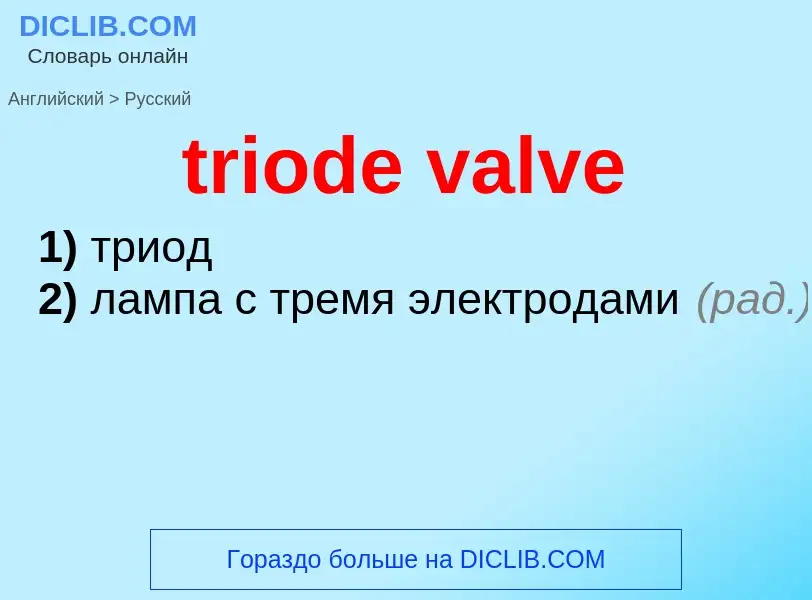Перевод и анализ слов искусственным интеллектом ChatGPT
На этой странице Вы можете получить подробный анализ слова или словосочетания, произведенный с помощью лучшей на сегодняшний день технологии искусственного интеллекта:
- как употребляется слово
- частота употребления
- используется оно чаще в устной или письменной речи
- варианты перевода слова
- примеры употребления (несколько фраз с переводом)
- этимология
triode valve - перевод на русский
[vælv]
общая лексика
вентиль
вентильный
задвижка
затвор
золотник
золотниковый
клапанный
кран
пневмоаппарат
электронная лампа
ботаника
вальва
створка
анатомия
клапан
медицина
заслонка
строительное дело
вентиль, задвижка, шибер
нефтегазовая промышленность
распределительный кран
подавать через клапан
существительное
общая лексика
клапан (на духовых инструментах)
клапан, вентиль
ламповый
клапанный
ботаника
вальва
створка
техника
клапан
вентиль
золотник
задвижка
заслонка
электроника
электронная лампа
музыка
пистон, вентиль
общая лексика
баугиниева заслонка
Википедия

A triode is an electronic amplifying vacuum tube (or valve in British English) consisting of three electrodes inside an evacuated glass envelope: a heated filament or cathode, a grid, and a plate (anode). Developed from Lee De Forest's 1906 Audion, a partial vacuum tube that added a grid electrode to the thermionic diode (Fleming valve), the triode was the first practical electronic amplifier and the ancestor of other types of vacuum tubes such as the tetrode and pentode. Its invention founded the electronics age, making possible amplified radio technology and long-distance telephony. Triodes were widely used in consumer electronics devices such as radios and televisions until the 1970s, when transistors replaced them. Today, their main remaining use is in high-power RF amplifiers in radio transmitters and industrial RF heating devices. In recent years there has been a resurgence in demand for low power triodes due to renewed interest in tube-type audio systems by audiophiles who prefer the pleasantly (warm) distorted sound of tube-based electronics.
The name "triode" was coined by British physicist William Eccles some time around 1920, derived from the Greek τρίοδος, tríodos, from tri- (three) and hodós (road, way), originally meaning the place where three roads meet.





![[[Gabe Newell]] (foreground) and Doug Lombardi (background), 2007 [[Gabe Newell]] (foreground) and Doug Lombardi (background), 2007](https://commons.wikimedia.org/wiki/Special:FilePath/Gabe newell doug lombardi.jpg?width=200)
![Robin Walker]] at Steam Dev Days 2014 Robin Walker]] at Steam Dev Days 2014](https://commons.wikimedia.org/wiki/Special:FilePath/Robin Walker 3.jpg?width=200)
![[[Globe valve]] [[Globe valve]]](https://commons.wikimedia.org/wiki/Special:FilePath/Globe valve (rendered).jpg?width=200)
![A valve controlled by a [[wheel]] (on vertical line) A valve controlled by a [[wheel]] (on vertical line)](https://commons.wikimedia.org/wiki/Special:FilePath/Green tubes and valves.jpg?width=200)
![Large [[butterfly valve]] Large [[butterfly valve]]](https://commons.wikimedia.org/wiki/Special:FilePath/Nasa-space-18408-l.jpg?width=200)
![Cast iron [[butterfly valve]] Cast iron [[butterfly valve]]](https://commons.wikimedia.org/wiki/Special:FilePath/Bidirectional tight butterfly valve-The-Alloy-Valve-Stockist.jpg?width=200)
![Hastelloy [[ball valve]] Hastelloy [[ball valve]]](https://commons.wikimedia.org/wiki/Special:FilePath/Hastelloy Ball valve.jpg?width=200)
![Stainless steel [[gate valve]] Stainless steel [[gate valve]]](https://commons.wikimedia.org/wiki/Special:FilePath/Valve.jpg?width=200)
![Inside view of a tilting disc inconel [[check valve]] Inside view of a tilting disc inconel [[check valve]]](https://commons.wikimedia.org/wiki/Special:FilePath/Inside-tilting-disc-check-valve-The-Alloy-Valve-Stockist.jpg?width=200)
![Large carbon steel swing [[check valve]] Large carbon steel swing [[check valve]]](https://commons.wikimedia.org/wiki/Special:FilePath/Large-swing-check-valve-The-Alloy-Valve-Stockist.jpg?width=200)
![Disc for an alloy [[check valve]] also known as axial check valve Disc for an alloy [[check valve]] also known as axial check valve](https://commons.wikimedia.org/wiki/Special:FilePath/Nozzle-check-valve-disc-The-Alloy-Valve-Stockist.jpg?width=200)
![Balls for alloy [[ball valve]]s Balls for alloy [[ball valve]]s](https://commons.wikimedia.org/wiki/Special:FilePath/Valve-balls-The-Alloy-Valve-Stockist.jpg?width=200)

![Ball for a titanium [[ball valve]] Ball for a titanium [[ball valve]]](https://commons.wikimedia.org/wiki/Special:FilePath/Ball-valve-ball-The-Alloy-Valve-Stockist.jpg?width=200)

.jpg?width=200)



![Integrated [[Helium release valve]] as used by the [[Rolex Sea-Dweller]] diving watch Integrated [[Helium release valve]] as used by the [[Rolex Sea-Dweller]] diving watch](https://commons.wikimedia.org/wiki/Special:FilePath/he_release_valve_seadweller.jpg?width=200)

